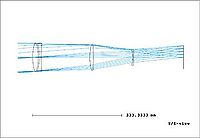Difference between revisions of "FSQ"
| Line 1: | Line 1: | ||
The FSQ telescope at Moore Observatory provides a very wide field with a high quality scientific CCD camera and a variety of filters. It permits photometry of bright stars, narrow spectral band surface photometry of nebulae, monitoring asteroid positions and rotation, and imaging comets and nebulae that span too much of the sky for the larger telescopes to capture in a single image. | The FSQ telescope at Moore Observatory provides a very wide field with a high quality scientific CCD camera and a variety of filters. It permits photometry of bright stars, narrow spectral band surface photometry of nebulae, monitoring asteroid positions and rotation, and imaging comets and nebulae that span too much of the sky for the larger telescopes to capture in a single image. Although useful for research, the FSQ is a public resource and will soon be available interactively on the web. | ||
== Optical System == | == Optical System == | ||
Revision as of 22:35, 30 October 2009
The FSQ telescope at Moore Observatory provides a very wide field with a high quality scientific CCD camera and a variety of filters. It permits photometry of bright stars, narrow spectral band surface photometry of nebulae, monitoring asteroid positions and rotation, and imaging comets and nebulae that span too much of the sky for the larger telescopes to capture in a single image. Although useful for research, the FSQ is a public resource and will soon be available interactively on the web.
Optical System
The FSQ-106ED uses two ED (extra-low dispersion) glass elements based on the classic two-doublet Petzval design. It provides very low levels of aberration and image sizes less than a single pixel of the CCD camera which is used with it:
Aperture: 4.2" or 106 mm
Focal ratio: f/5
Focal length: 530 mm
Focal plane scale: 0.108 degrees/mm or 389 "/mm
